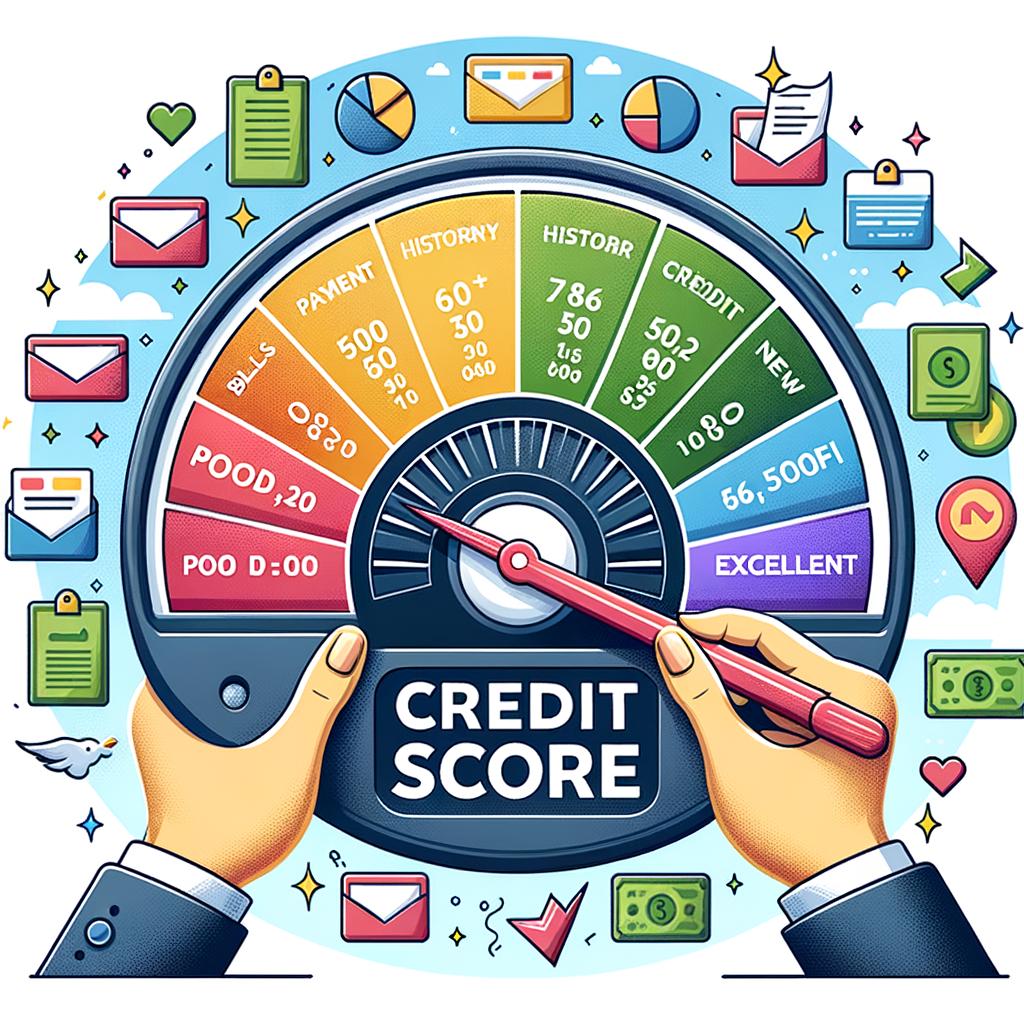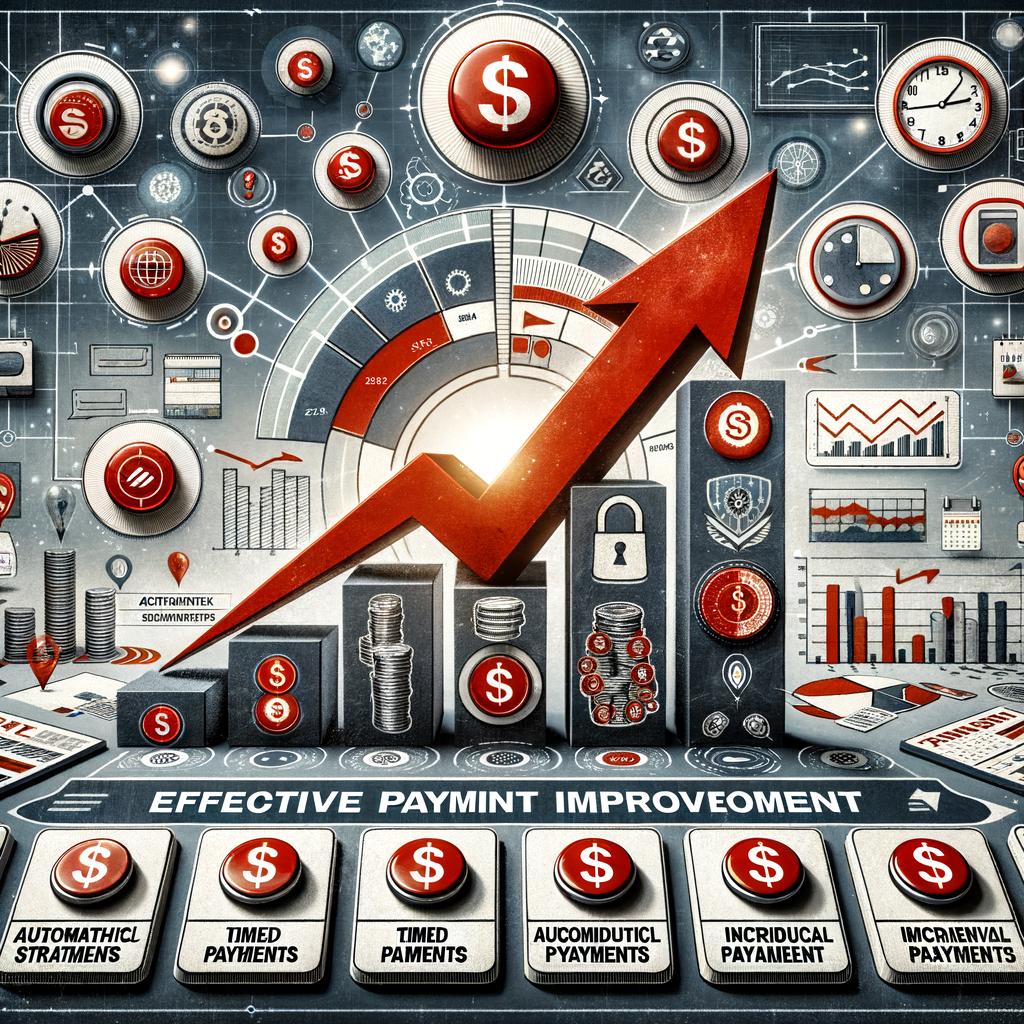Navigating the world of credit scores can often feel like untangling a web of complex information, financial jargon, and a seemingly elusive set of rules. Yet, your credit score wields significant influence, affecting everything from your ability to secure a mortgage to the interest rates you’ll pay on loans. It’s the silent partner in many of your financial decisions. Understanding and improving this crucial number can empower you, offering access to better financial opportunities and greater peace of mind. In this article, we unravel the intricacies of credit scores and provide you with ten actionable tips and strategies to help bolster your score. Whether you’re just beginning to build credit or seeking to repair past financial missteps, these insights will guide you on the path to a healthier credit profile. So, let’s dive in and transform the way you view and manage your credit.
Table of Contents
- Understanding the Credit Score Basics
- Effective Payment Strategies for Steady Improvement
- Leveraging Credit Utilization for Maximum Impact
- Navigating Credit Report Errors and Disputes
- Q&A
- In Conclusion

Understanding the Credit Score Basics
Credit scores play a pivotal role in determining your financial health and future borrowing capabilities. These three-digit numbers are calculated based on various factors designed to predict your credit behavior. FICO and VantageScore are the most widely used credit scoring models, and understanding the contributing elements can help you manage and improve your score effectively.
Payment History substantially influences your credit score, accounting for about 35% of the total in the FICO model. This means that paying your bills on time is pivotal. Late payments, defaults, and bankruptcies can drastically lower your score, emphasizing the need for timely payments.
Another crucial factor is your Credit Utilization Ratio. This ratio measures the amount of credit you’re using in relation to your credit limit. Ideally, you should keep your credit utilization below 30%. If your credit limit is $10,000, aim to use less than $3,000. Maintaining a low credit utilization ratio signals to lenders that you manage credit responsibly.
Length of Credit History is another determinant that makes up approximately 15% of your score. This involves the age of your oldest account, the age of your newest account, and the average age of all your accounts. A longer credit history generally boosts your score, so it might be more beneficial to keep older accounts open, even if they’re not actively used.
Credit Mix can also impact your score. Lenders like to see a variety of credit types in your history, including credit cards, mortgages, auto loans, and personal loans. A diverse credit portfolio shows that you can manage different kinds of debt. However, don’t open new credit accounts just for the sake of diversifying your credit mix – only take on new debt when necessary.
New credit inquiries might be seen as a red flag for potential overborrowing. Hard inquiries, such as those from credit card or loan applications, can lower your score temporarily. Conversely, soft inquiries, often related to background checks or pre-qualified credit offers, do not affect your score. Limiting unnecessary hard inquiries is essential for maintaining a healthy score.
Here’s a quick summary table for your reference:
| Factor | Impact on Score |
|---|---|
| Payment History | 35% |
| Credit Utilization Ratio | 30% |
| Length of Credit History | 15% |
| Credit Mix | 10% |
| New Credit Inquiries | 10% |
It’s vital to regularly monitor your credit reports to track your progress and spot any errors or suspicious activities. You’re entitled to a free credit report from each of the three major credit bureaus—Equifax, Experian, and TransUnion—once a year from AnnualCreditReport.com. Regular checks can help you maintain a healthy credit score and quickly address any issues that arise.
Lastly, patience and persistence are key when it comes to improving your credit score. Changes don’t happen overnight, but with consistent effort in managing payments, keeping balances low, and being mindful of new credit applications, you’ll see improvement over time.

Effective Payment Strategies for Steady Improvement
When it comes to boosting your credit score, employing effective payment strategies can make a significant difference. Implementing a disciplined payment regimen not only demonstrates reliability but also builds a solid credit history.
A powerful approach is to automate your payments. By setting up automatic payments for your credit cards, loans, and utilities, you minimize the risk of missing a due date. Most banks and financial institutions offer this feature, ensuring that you’ll never incur a late fee or a ding to your credit score because of an oversight.
It’s also prudent to make more than the minimum payment each month. Paying only the minimum can lead you into a cycle of debt due to high interest rates. Even an extra $50 a month towards your credit card debt can show commitment to reducing your balance and improving your utilization rate.
Utilize the strategy of debt snowballing or the debt avalanche method. In the debt snowball method, focus on paying off the smallest debts first while making minimum payments on larger ones. This can provide psychological boosts and a sense of achievement. The debt avalanche method, on the other hand, targets debts with the highest interest rates first, saving you more on interest over time. Decide which approach fits your financial situation and commit to it.
Leverage the benefit of bi-weekly payments. Instead of making one monthly payment, split it into two equal payments every two weeks. This results in 26 half-payments, equating to 13 full payments in a year instead of 12. This tactic can reduce the overall interest due and help pay down the principal faster.
- Negotiate with creditors: If you’re struggling, many creditors offer hardship programs. These can include reduced interest rates, fee waivers, or extended payment plans.
- Consolidate your debts: If managing multiple payments is challenging, consider a debt consolidation loan which might offer a lower interest rate and streamline your monthly obligations.
- Maintain consistent payments: Always keep your payment history spotless by never missing a payment. Even a single 30-day late payment can drastically affect your credit score.
Consider using a detailed schedule or a payment calendar to keep track of all your payment due dates. Visual reminders can be effective. Below is an example of a simple payment calendar:
| Week | Payment Due | Amount |
|---|---|---|
| Week 1 | Credit Card A | $150 |
| Week 2 | Loan B | $200 |
| Week 3 | Credit Card B | $100 |
| Week 4 | Utilities | $120 |
Employ the practice of paying bills promptly. Payment history is one of the most significant factors influencing your credit score. Consistent, on-time payments exhibit financial responsibility and can rapidly improve your score over time.
Lastly, don’t underestimate the effectiveness of keeping old accounts open. The length of your credit history plays a crucial role in your overall credit score. Older accounts with positive payment records work in your favor, so avoid the temptation to close them, even if they’re fully paid off.
By making these strategies part of your financial habits, you can create a stable platform for ongoing improvement of your credit score, setting yourself up for better interest rates and loan approval odds in the future.

Leveraging Credit Utilization for Maximum Impact
One of the most impactful factors in improving your credit score is how you manage your credit utilization ratio. Credit utilization refers to the percentage of your total available credit that you are currently using. Keeping this number low shows creditors that you are not overly reliant on credit, which positively influences your credit score.
Imagine your total credit limit is $10,000. If you have an outstanding balance of $2,500, your credit utilization ratio is 25%. A general rule of thumb is to keep this ratio below 30%, but for optimal results, aim for 10% or lower.
<table class="wp-block-table">
<thead>
<tr>
<th>Credit Limit</th>
<th>Outstanding Balance</th>
<th>Utilization Ratio</th>
</tr>
</thead>
<tbody>
<tr>
<td>$10,000</td>
<td>$2,500</td>
<td>25%</td>
</tr>
<tr>
<td>$10,000</td>
<td>$1,000</td>
<td>10%</td>
</tr>
<tr>
<td>$10,000</td>
<td>$500</td>
<td>5%</td>
</tr>
</tbody>
</table>
Consider the following strategies to effectively manage your credit utilization:
<ul>
<li><strong>Pay Down Balances Early</strong>: Instead of waiting until the due date, make payments as soon as you can. This can reduce your balance well before the billing cycle ends, reflecting a lower utilization when it is reported to credit bureaus.</li>
<li><strong>Increase Your Credit Limits</strong>: Requesting a higher credit limit increases your total available credit, which can immediately lower your utilization ratio. Ensure you do this without increasing your total debt.</li>
<li><strong>Spread Out Your Charges</strong>: Use multiple credit cards rather than relying heavily on one. This disperses your available credit and helps maintain a lower utilization rate on each card.</li>
</ul>
Be mindful to not mistakenly close unused credit cards, as this decreases your total available credit and can increase your utilization rate dramatically. Keep the account open and occasionally use it for small purchases to keep it active.
Another vital tip is to set up balance alerts. Many credit card companies offer tools to notify you when your balance reaches a certain threshold. This can help you stay on top of your spending and ensure you don’t accidentally exceed a healthy utilization rate.
You should also consider making multiple payments throughout the month. Splitting payments can prevent your balance from ballooning and help maintain a consistently low utilization percentage.
By leveraging these techniques, you will not only improve your credit score but also cultivate better financial habits. Monitoring and actively managing credit utilization can lead to a healthier financial future.

Navigating Credit Report Errors and Disputes
Errors on your credit report can be the silent killers of your credit score. Addressing these inaccuracies promptly can lead to significant improvements in your credit health. Start by obtaining copies of your credit report from the three major bureaus: Experian, Equifax, and TransUnion. Once you have them, closely inspect each report for any discrepancies.
Common errors to look out for include:
- Incorrect personal information
- Accounts that don’t belong to you
- Outdated information
- Incorrect account statuses
If you find any errors, file a dispute with the credit bureau that provided the inaccurate report. Make sure to clearly state what information you believe is incorrect and provide any supporting documentation you have. The process can usually be done online, which is faster and more efficient.
Here’s a snapshot of the basic dispute procedures for the three major bureaus:
| Credit Bureau | Dispute Method | Processing Time |
|---|---|---|
| Experian | Online, Mail | 30 days |
| Equifax | Online, Mail | 30 days |
| TransUnion | Online, Mail | 30 days |
While the credit bureaus investigate your dispute, they will communicate with the information provider (such as a bank or credit card company). By law, the investigation must usually be completed within 30 days. You will be notified of the results and whether they’ve made any changes to your report.
In the meantime, there are steps you can take to protect your credit score. Continue to pay your bills on time and keep your credit card balances low. These measures ensure that your score is not further impacted while waiting for corrections to your report.
It’s important to keep records of all communications, including copies of any letters you send and notes on any phone calls. If a dispute does not result in a correction, you have the option to add a consumer statement to your credit report. This statement allows you to explain any valid but potentially misleading information on your credit report, offering context for future creditors who review your report.
Regularly monitoring your credit report is crucial to ensuring its accuracy. Many financial institutions offer free credit monitoring services, or you can use third-party services dedicated to tracking your credit health. By keeping vigil over your credit report, you can catch and address errors sooner, maintaining a healthier financial profile in the process.
Q&A
Q&A: 10 Tips and Strategies To Improve Your Credit Score
Q1: Why is an improved credit score important?
A1: An improved credit score can unlock numerous financial benefits. It often results in better interest rates on loans and credit cards, making borrowing cheaper. Additionally, a higher credit score can enhance your ability to secure rental agreements, obtain favorable insurance premiums, and even boost your chances of landing a job.
Q2: What’s the first step to take to start improving a credit score?
A2: The first step is assessing your current credit situation. This involves obtaining a copy of your credit report from major credit reporting agencies like Equifax, Experian, and TransUnion. Review the report thoroughly to identify any inaccuracies or areas for improvement.
Q3: How does paying bills on time impact your credit score?
A3: Timely bill payments are one of the most significant factors influencing your credit score. Consistent, on-time payments demonstrate to creditors that you are reliable and creditworthy, which can positively impact your credit score over time.
Q4: Are there any tips for managing credit card balances effectively?
A4: Yes, it’s crucial to keep your credit card balances low relative to your credit limit. Aim to use less than 30% of your available credit, as high credit utilization can negatively impact your credit score. Paying down your balances and avoiding maxing out your cards are effective strategies.
Q5: How can setting up automatic payments help?
A5: Setting up automatic payments ensures that your bills are paid on time, every time. This reduces the risk of late payments, which can adversely affect your score. Plus, it simplifies your financial management by reducing the need to remember multiple due dates.
Q6: Does opening new lines of credit help or hurt your score?
A6: Opening new lines of credit can have both positive and negative effects. While it might provide more available credit, thereby lowering your credit utilization ratio, each new application results in a hard inquiry on your credit report, which can temporarily lower your score.
Q7: Why should you avoid closing old credit accounts?
A7: Closing old credit accounts can negatively impact your credit history length, which accounts for a portion of your credit score. Keeping these accounts open, even if unused, can demonstrate a longer history of credit management.
Q8: How can diversifying your credit mix influence your score?
A8: A mix of different types of credit, such as credit cards, mortgages, and installment loans, can positively influence your credit score. It shows that you can manage various types of credit responsibly.
Q9: Are there specific strategies for addressing debt?
A9: Yes, tackling your debt methodically can improve your credit score. Consider strategies like the debt snowball method (paying off small debts first) or the debt avalanche method (tackling debts with the highest interest rates first). Both can help reduce your total debt load effectively.
Q10: What role does credit monitoring play in improving credit scores?
A10: Credit monitoring services alert you to changes in your credit report and can help you catch signs of potential identity theft or errors. Regular monitoring allows you to address issues promptly, ensuring your credit score reflects accurate and up-to-date information.
By following these tips and strategies, individuals can take proactive steps toward improving their credit scores, thereby enhancing their overall financial health and opportunities.
In Conclusion
As we wrap up our exploration of the 10 tips and strategies to improve your credit score, remember that every journey toward better financial health begins with a single step. Now armed with these practical insights, you possess the tools to take control of your credit destiny. Whether it’s mastering the art of timely payments, understanding the nuances of your credit utilization, or navigating the complexities of your credit report with a discerning eye, each strategy is a rung on the ladder to financial stability.
Think of your credit score as a living, breathing narrative of your fiscal responsibility—a story you edit with every conscious decision. Cultivating a robust credit profile doesn’t happen overnight, but with patience and persistence, the cumulative impact of these tips can set the stage for a brighter, more secure future.
So, go forth with confidence and purpose. The road to improved creditworthiness might have its twists and turns, but with each strategy implemented, you’re steering towards a horizon full of opportunities. Here’s to transforming those tips into tangible progress and watching your credit score bloom. Happy financial navigating!
